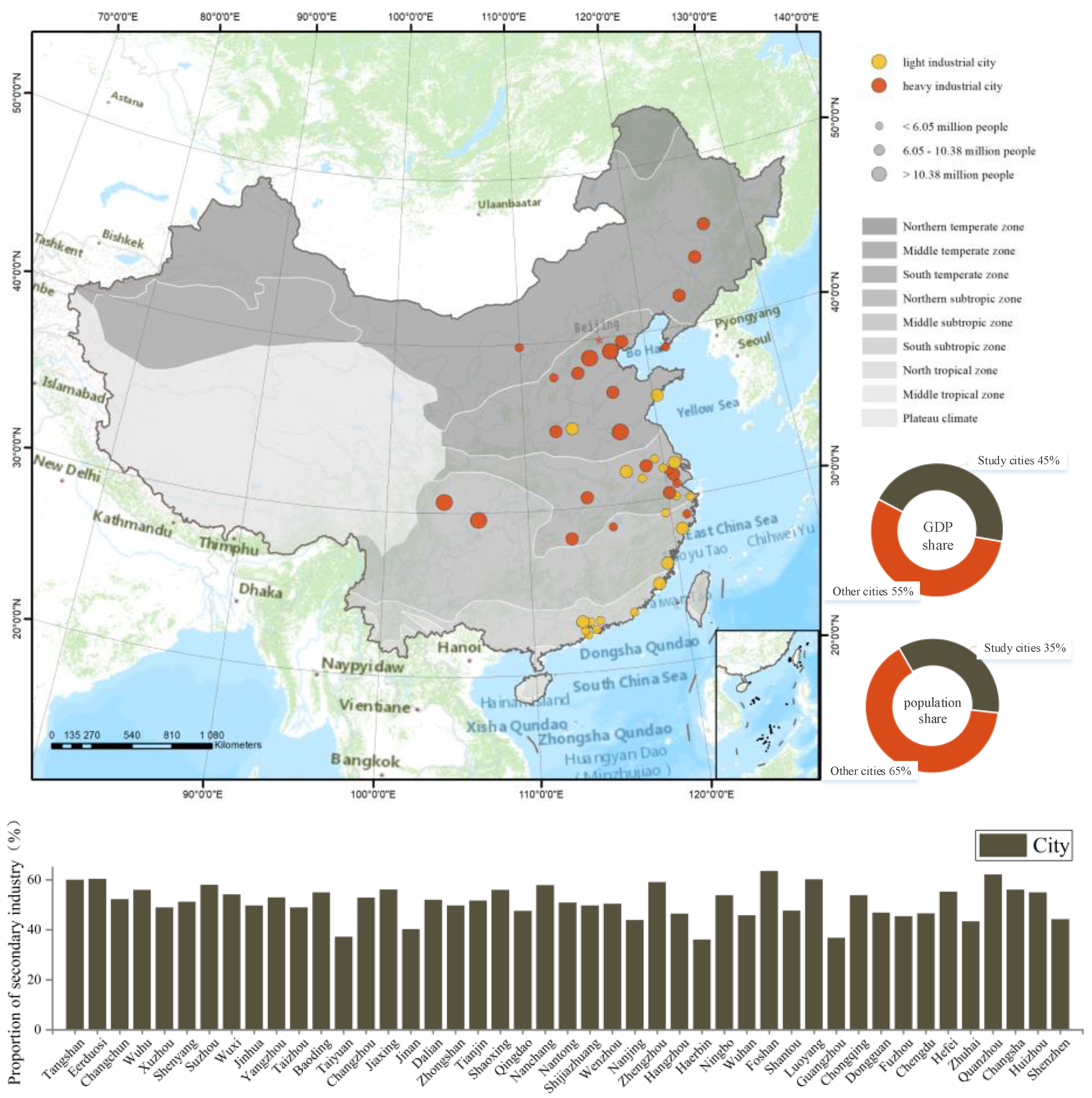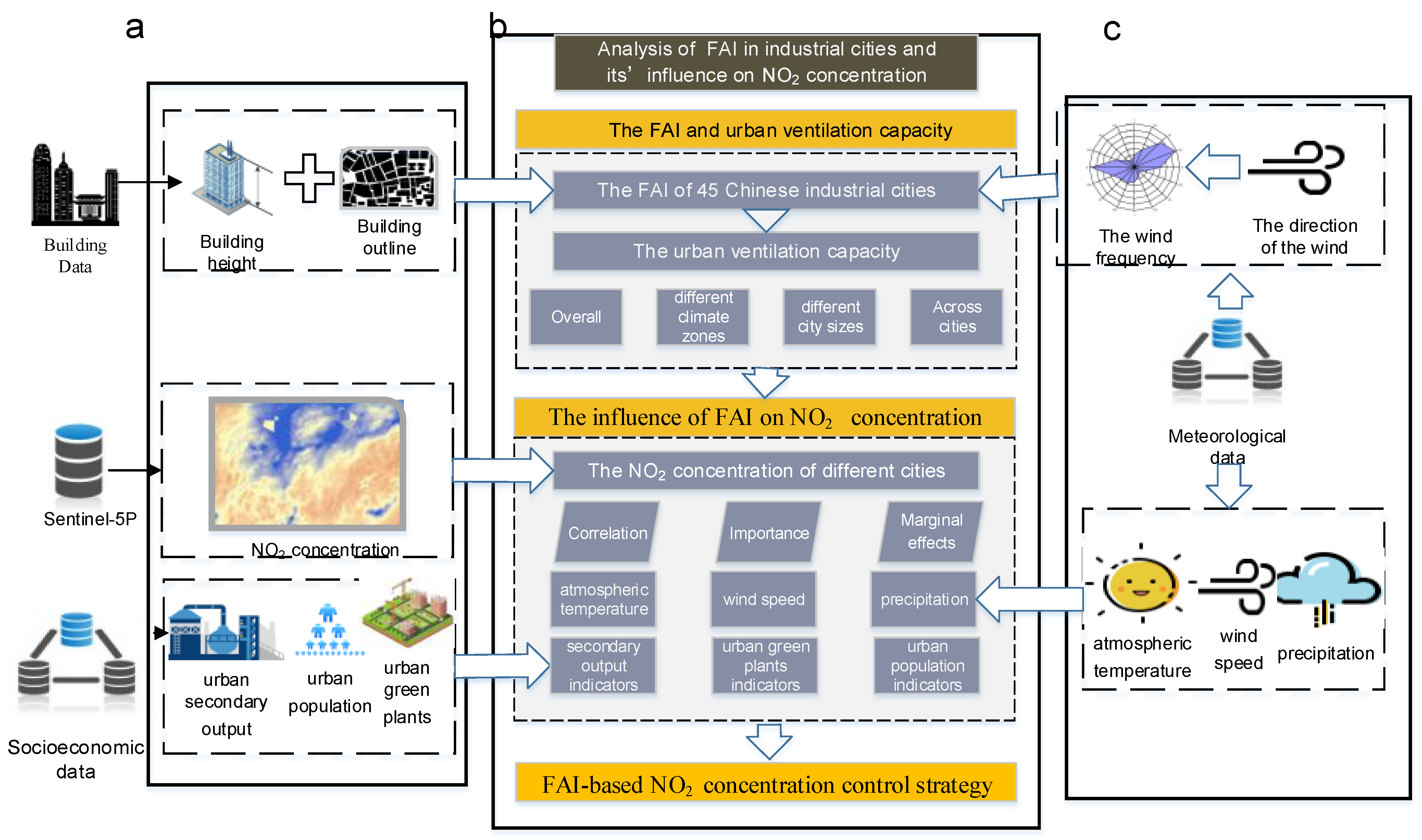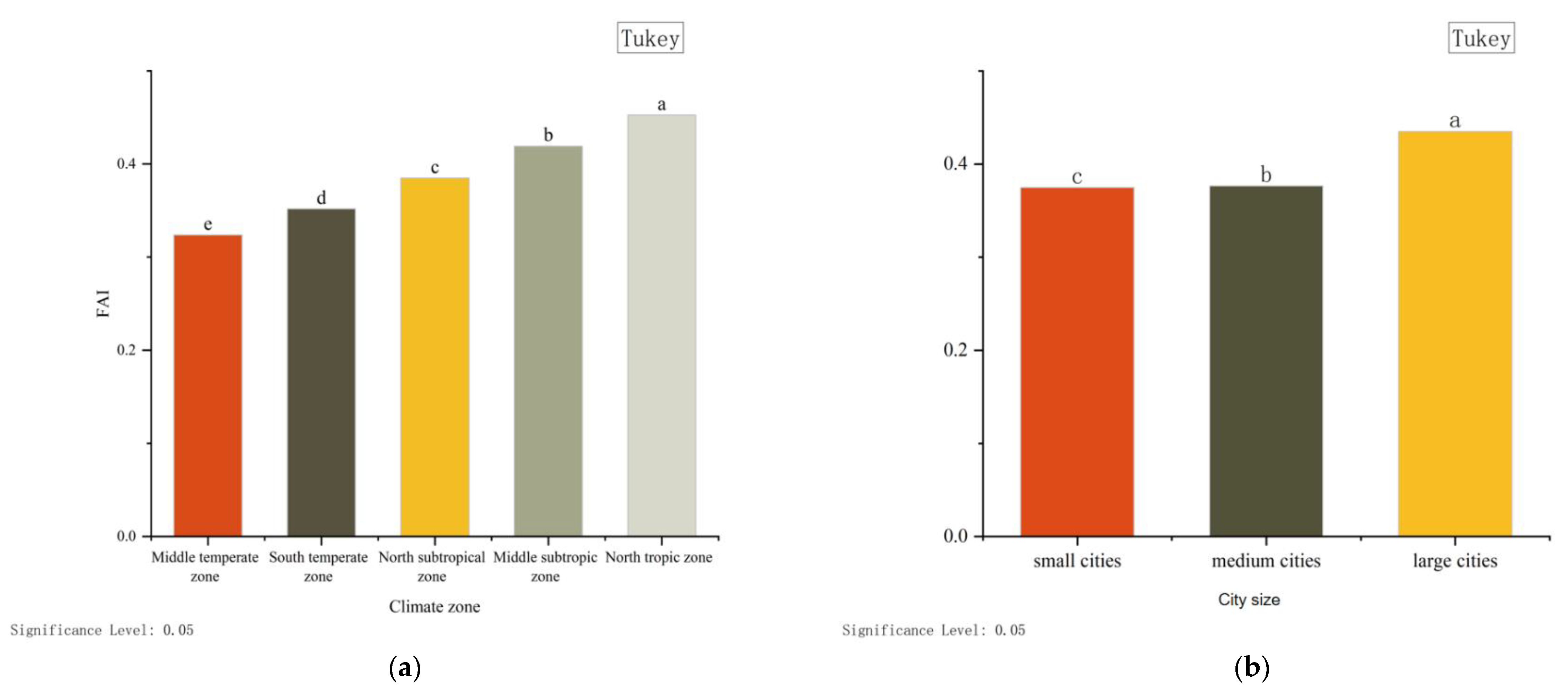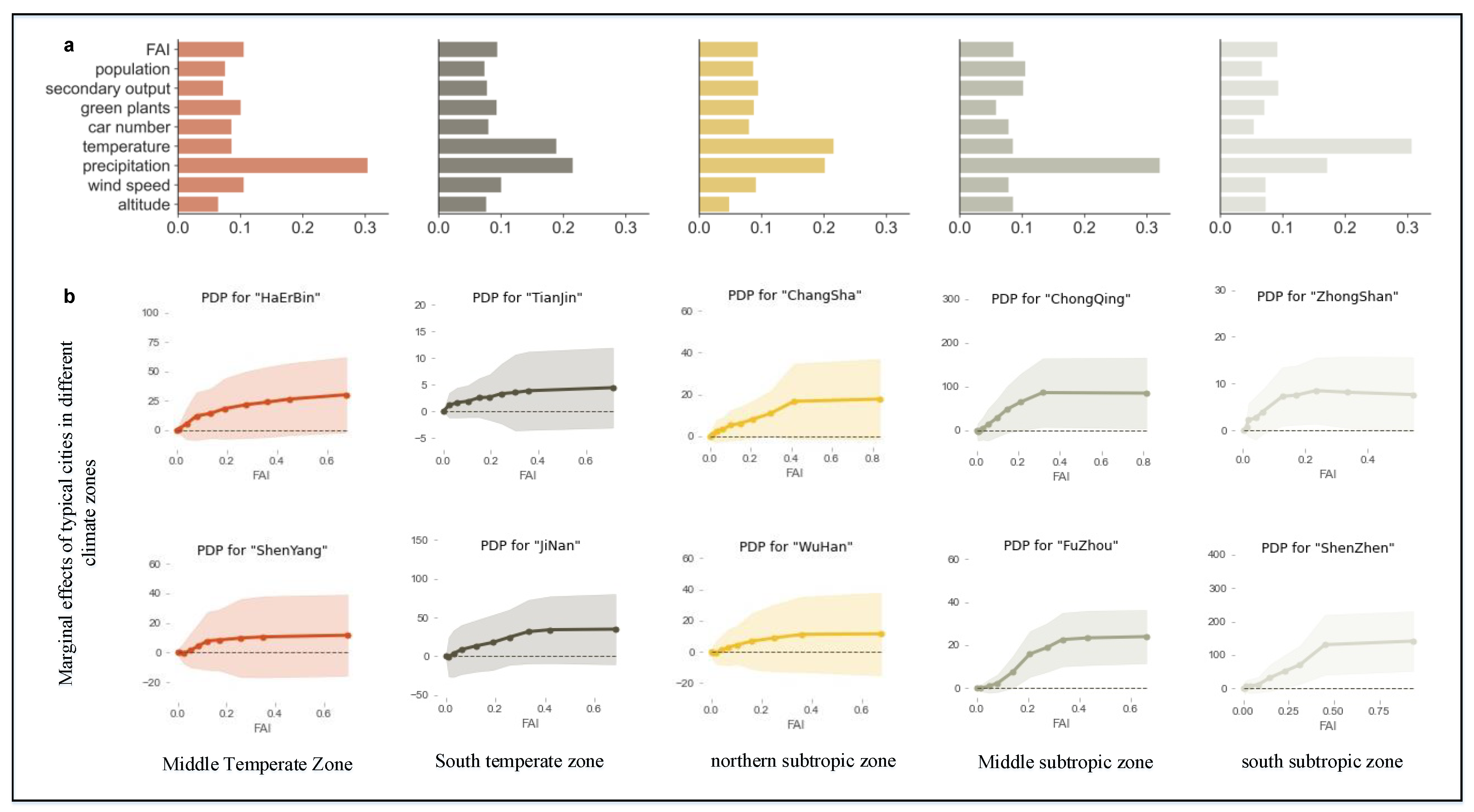Ventilation Capacities of Chinese Industrial Cities and Their Influence on the Concentration of NO2
Abstract
:1. Introduction
2. Materials and Methods
2.1. Study Area
2.2. Research Framework and Data Source
- (1)
- FAI calculation: We used construction data for 1,877,100 buildings in 45 Chinese cities, which we obtained from Baidu Maps (https://lbsyun.baidu.com/ (accessed on 20 June 2021)).The construction information included the outline and height, and the urban areas were divided into regular grids with a resolution of 1 km × 1 km. NO2 has a very strong diurnal cycle, with large differences between day and night. However, the satellite–5P data that we used only reflect the local NO2 concentration at noon. In order to match the satellite data, we obtained the daytime wind data from each city’s weather station and calculated the wind frequency for the different wind directions. Based on this, FAI and NO2 concentration maps were plotted one by one. Finally, the FAI of each grid was calculated using ArcGIS (see research methods for details).
- (2)
- Evaluation of the urban ventilation capacity based on the FAI: FAI was used to evaluate the overall ventilation capacities of the 45 cities, and the paired difference test method was used to compare the ventilation capacities of the industrial cities of different sizes and in different climate zones.
- (3)
- The influence of FAI on the NO2 concentration: We determined the correlation between the FAI and NO2 concentration using correlation analysis. Then, we compared the relative contribution to and marginal effect of the FAI on the NO2 concentration with other factors (such as the Normalized Difference Vegetation Index (NDVI) and the secondary output value) using the random forest regression method. In addition, the impact of FAI on the NO2 concentration was explored. The data used in this study are presented in Table 1.
2.3. Research Method
2.3.1. Calculation of FAI Based on ArcGIS
Calculation of FAI
FAI Calculation Realization
Ventilation Capacity Classification Based on FAI
2.3.2. Relative Contribution to and the Marginal Effect of FAI on the NO2 Concentration
Selection of Influencing Factors
Random Forest Regression
3. Results
3.1. Analysis of Overall Ventilation Capacities of Industrial Cities Based on FAI
3.2. Analysis of Ventilation Capacity Differences in Industrial Cities Based on FAI
3.3. Influence of FAI on NO2 Concentration in Industrial Cities
4. Discussion
4.1. FAI–Based NO2 Concentration Control Strategy
4.2. FAI–Based NO2 Concentration Control Strategy
4.3. Future Work
5. Conclusions
Author Contributions
Funding
Acknowledgments
Conflicts of Interest
Appendix A

References
- Salmond, J.; Sabel, C.E.; Vardoulakis, S. Towards the Integrated Study of Urban Climate, Air Pollution, and Public Health. Climate 2018, 6, 14. [Google Scholar] [CrossRef] [Green Version]
- Hertel, O.; Goodsite, M. Urban Air Pollution Climates Throughout the World. In Issues in Environmental Science and Technology; Royal Society of Chemistry: Cambridge, UK, 2009; Volume 28, pp. 1–22. [Google Scholar]
- Givati, A.; Rosenfeld, D. Quantifying Precipitation Suppression Due to Air Pollution. J. Appl. Meteorol. 2004, 43, 1038–1056. [Google Scholar] [CrossRef]
- Zheng, Z.; Ren, G.; Wang, H.; Dou, J.; Gao, Z.; Duan, C.; Li, Y.; Ngarukiyimana, J.P.; Zhao, C.; Cao, C.; et al. Relationship Between Fine-Particle Pollution and the Urban Heat Island in Beijing, China: Observational Evidence. Bound.-Lay. Meteorol. 2018, 169, 93–113. [Google Scholar] [CrossRef]
- Cao, C.; Lee, X.; Liu, S.; Schultz, N.; Xiao, W.; Zhang, M.; Zhao, L. Urban heat islands in China enhanced by haze pollution. Nat. Commun. 2016, 7, 12509. [Google Scholar] [CrossRef] [PubMed]
- Zhou, Y.; Zhang, G.; Jiang, L.; Chen, X.; Xie, T.; Wei, Y.; Xu, L.; Pan, Z.; An, P.; Lun, F. Mapping local climate zones and their associated heat risk issues in Beijing: Based on open data. Sustain. Cities Soc. 2021, 74, 103174. [Google Scholar] [CrossRef]
- Yamamoto, S.S.; Phalkey, R.; Malik, A.A. A systematic review of air pollution as a risk factor for cardiovascular disease in South Asia: Limited evidence from India and Pakistan. Int. J. Hydrogen. Environ. Health 2014, 217, 133–144. [Google Scholar] [CrossRef]
- Hoq, M.N.; Alam, R.; Amin, A. Prediction of Possible Asthma Attack from Air Pollutants: Towards a High Density Air Pollution Map for Smart Cities to Improve Living. In Proceedings of the 2019 International Conference on Electrical, Computer and Communication Engineering (ECCE), Cox’s Bazar, Bangladesh, 7–9 February 2019; pp. 1–5. [Google Scholar]
- Berkowicz, R.; Palmgren, F.; Hertel, O.; Vignati, E. Using measurements of air pollution in streets for evaluation of urban air quality—Meterological analysis and model calculations. Sci. Total Environ. 1996, 189–190, 259–265. [Google Scholar] [CrossRef]
- Miao, S.; Li, P.; Wang, X. Building morphological characteristics and their effect on the wind in Beijing. Adv. Atmos. Sci. 2009, 26, 1115. [Google Scholar] [CrossRef]
- Chen, G.; Rong, L.; Zhang, G. Impacts of urban geometry on outdoor ventilation within idealized building arrays under unsteady diurnal cycles in summer. Build. Environ. 2021, 206, 108344. [Google Scholar] [CrossRef]
- Peng, Y.; Gao, Z.; Buccolieri, R.; Shen, J.; Ding, W. Urban ventilation of typical residential streets and impact of building form variation. Sustain. Cities Soc. 2021, 67, 102735. [Google Scholar] [CrossRef]
- Bai, L.; Jiang, L.; Yang, D.; Liu, Y. Quantifying the spatial heterogeneity influences of natural and socioeconomic factors and their interactions on air pollution using the geographical detector method: A case study of the Yangtze River Economic Belt, China. J. Clean. Prod. 2019, 232, 692–704. [Google Scholar] [CrossRef]
- He, J.; Gong, S.; Yu, Y.; Yu, L.; Wu, L.; Mao, H.; Song, C.; Zhao, S.; Liu, H.; Li, X.; et al. Air pollution characteristics and their relation to meteorological conditions during 2014–2015 in major Chinese cities. Environ. Pollut. 2017, 223, 484–496. [Google Scholar] [CrossRef] [PubMed]
- Ma, T.; Duan, F.; He, K.; Qin, Y.; Tong, D.; Geng, G.; Liu, X.; Li, H.; Yang, S.; Ye, S.; et al. Air pollution characteristics and their relationship with emissions and meteorology in the Yangtze River Delta region during 2014–2016. J. Environ. Sci.-China 2019, 83, 8–20. [Google Scholar] [CrossRef] [PubMed]
- Qin, J.; Wang, S.; Guo, L.; Xu, J. Spatial Association Pattern of Air Pollution and Influencing Factors in the Beijing–Tianjin–Hebei Air Pollution Transmission Channel: A Case Study in Henan Province. Int. J. Environ. Res. Public Health 2020, 17, 1598. [Google Scholar] [CrossRef] [Green Version]
- Lamsal, L.N.; Martin, R.V.; Parrish, D.D.; Krotkov, N.A. Scaling Relationship for NO2 Pollution and Urban Population Size: A Satellite Perspective. Environ. Sci. Technol. 2013, 47, 7855–7861. [Google Scholar] [CrossRef]
- Wong, M.S.; Nichol, J.; Ng, E. A study of the “wall effect” caused by proliferation of high-rise buildings using GIS techniques. Landsc. Urban Plan. 2011, 102, 245–253. [Google Scholar] [CrossRef]
- Yang, J.; Wang, Y.; Xue, B.; Li, Y.; Xiao, X.; Xia, J.C.; He, B. Contribution of urban ventilation to the thermal environment and urban energy demand: Different climate background perspectives. Sci. Total Environ. 2021, 795, 148791. [Google Scholar] [CrossRef]
- Jiang, Z.; Cheng, H.; Zhang, P.; Kang, T. Influence of urban morphological parameters on the distribution and diffusion of air pollutants: A case study in China. J. Environ. Sci.-China 2021, 105, 163–172. [Google Scholar] [CrossRef]
- Shi, Y.; Xie, X.; Fung, J.C.; Ng, E. Identifying critical building morphological design factors of street-level air pollution dispersion in high-density built environment using mobile monitoring. Build. Environ. 2018, 128, 248–259. [Google Scholar] [CrossRef] [Green Version]
- Gál, T.M.; Sümeghy, Z. Mapping the roughness parameters in a large urban area for urban climate applications. Acta Climatol. ET Chorol. 2007, 40, 27–36. [Google Scholar]
- Gál, T.; Unger, J. Detection of ventilation paths using high-resolution roughness parameter mapping in a large urban area. Build. Environ. 2009, 44, 198–206. [Google Scholar] [CrossRef]
- Lettau, H. Note on Aerodynamic Roughness-Parameter Estimation on the Basis of Roughness-Element Description. J. Appl. Meteorol. Clim. 1969, 8, 828–832. [Google Scholar] [CrossRef] [Green Version]
- Ratti, C.; Di Sabatino, S.; Britter, R.; Brown, M.; Caton, F.; Burian, S. Analysis of 3-D Urban Databases with Respect to Pollution Dispersion for a Number of European and American Cities. Water Air Soil Pollut. Focus 2002, 2, 459–469. [Google Scholar] [CrossRef]
- Yuan, C.; Ren, C.; Ng, E. GIS-based surface roughness evaluation in the urban planning system to improve the wind environment—A study in Wuhan, China. Urban Clim. 2014, 10, 585–593. [Google Scholar] [CrossRef]
- Hu, J.; Wang, Y.; Ying, Q.; Zhang, H. Spatial and temporal variability of PM2.5 and PM10 over the North China Plain and the Yangtze River Delta, China. Atmos. Environ. 2014, 95, 598–609. [Google Scholar] [CrossRef]
- Song, C.; Wu, L.; Xie, Y.; He, J.; Chen, X.; Wang, T.; Lin, Y.; Jin, T.; Wang, A.; Liu, Y.; et al. Air pollution in China: Status and spatiotemporal variations. Environ. Pollut. 2017, 227, 334–347. [Google Scholar] [CrossRef]
- Xu, W.; Sun, J.; Liu, Y.; Xiao, Y.; Tian, Y.; Zhao, B.; Zhang, X. Spatiotemporal variation and socioeconomic drivers of air pollution in China during 2005–2016. J. Environ. Manag. 2019, 245, 66–75. [Google Scholar] [CrossRef]
- Zeng-kai, Z.; Yu-ting, L.; Peng-yu, Z.; Yuan, W.; Ning, J.; Alam, R. The assessment of economic cost induced by emergency responses for heavy pollution weather within Jing-Jin-Ji area in 2019. China Environ. Sci. 2021, 41, 3399–3408. [Google Scholar]
- Prunet, P.; Lezeaux, O.; Camy-Peyret, C.; Thevenon, H. Analysis of the NO2 tropospheric product from S5P TROPOMI for monitoring pollution at city scale. City Environ. Interact. 2020, 8, 100051. [Google Scholar] [CrossRef]
- Zhao, S.; Liu, S.; Hou, X.; Cheng, F.; Wu, X.; Dong, S.; Beazley, R. Temporal dynamics of SO2 and NOX pollution and contributions of driving forces in urban areas in China. Environ. Pollut. 2018, 242, 239–248. [Google Scholar] [CrossRef]
- Anenberg, S.C.; Horowitz, L.W.; Tong, D.Q.; West, J.J. An Estimate of the Global Burden of Anthropogenic Ozone and Fine Particulate Matter on Premature Human Mortality Using Atmospheric Modeling. Environ. Health Perspect. 2010, 118, 1189–1195. [Google Scholar] [CrossRef] [PubMed]
- Bert, B.; Stephen, T.H. Air pollution and health. Lancet 2002, 360, 1233–1242. [Google Scholar]
- Townsend, A.R.; Howarth, R.W.; Bazzaz, F.A.; Booth, M.S.; Cleveland, C.C.; Collinge, S.K.; Collinge, A.P.; Dobson, P.R.; Epstein, E.A.; Holland, D.R.; et al. Human Health Effects of a Changing Global Nitrogen Cycle. Front. Ecol. Environ. 2003, 1, 240–246. [Google Scholar] [CrossRef]
- US EPA National Center for Environmental Assessment-RTP Division; Luben, T. Integrated Science Assessment for Oxides of Nitrogen—Health Criteria; US EPA—Environmental Protection Agency: Washington, DC, USA, 2008. [Google Scholar]
- Shi, Y.; Lau, K.K.; Ng, E. Incorporating wind availability into land use regression modelling of air quality in mountainous high-density urban environment. Environ. Res. 2017, 157, 17–29. [Google Scholar] [CrossRef]
- Wei, S.; Huang, H.C.; Yang, J. An optimization algorithm for calculating the frontal area ratio. Jilin Norm. Univ. J. (Nat. Sci. Ed.) 2019, 40, 136–140. [Google Scholar]
- Grimmond, C.S.B.; Oke, T.R. Aerodynamic Properties of Urban Areas Derived from Analysis of Surface Form. J. Appl. Meteorol. 1999, 38, 1262–1292. [Google Scholar] [CrossRef]
- Rotach, M.W. Determination of the zero plane displacement in an urban environment. Bound.-Lay. Meteorol. 1994, 67, 187–193. [Google Scholar] [CrossRef]
- Ng, E.; Yuan, C.; Chen, L.; Ren, C.; Fung, J.C.H. Improving the wind environment in high-density cities by understanding urban morphology and surface roughness: A study in Hong Kong. Landsc. Urban Plan. 2011, 101, 59–74. [Google Scholar] [CrossRef]
- Yuan, C.; Ng, E.; Norford, L.K. Improving air quality in high-density cities by understanding the relationship between air pollutant dispersion and urban morphologies. Build. Environ. 2014, 71, 245–258. [Google Scholar] [CrossRef]
- Li, J.; Lin, B. Ecological total-factor energy efficiency of China’s heavy and light industries: Which performs better? Renew. Sustain. Energy Rev. 2017, 72, 83–94. [Google Scholar] [CrossRef]
- Wang, Y.; Liu, C.; Wang, Q.; Qin, Q.; Ren, H.; Cao, J. Impacts of natural and socioeconomic factors on PM2.5 from 2014 to 2017. J. Environ. Manag. 2021, 284, 112071. [Google Scholar] [CrossRef] [PubMed]
- Zhang, X.; Yan, B.; Du, C.; Cheng, C.; Zhao, H. Quantifying the interactive effects of meteorological, socioeconomic, and pollutant factors on summertime ozone pollution in China during the implementation of two important policies. Atmos. Pollut. Res. 2021, 12, 101248. [Google Scholar] [CrossRef]
- Han, L.; Zhou, W.; Li, W.; Meshesha, D.T.; Li, L.; Zheng, M. Meteorological and urban landscape factors on severe air pollution in Beijing. J. Air Waste Manag. 2015, 65, 782–787. [Google Scholar] [CrossRef] [Green Version]
- Liu, H.; Fang, C.; Zhang, X.; Wang, Z.; Bao, C.; Li, F. The effect of natural and anthropogenic factors on haze pollution in Chinese cities: A spatial econometrics approach. J. Clean. Prod. 2017, 165, 323–333. [Google Scholar] [CrossRef]
- Yang, D.; Wang, X.; Xu, J.; Xu, C.; Lu, D.; Ye, C.; Wang, Z.; Bai, L. Quantifying the influence of natural and socioeconomic factors and their interactive impact on PM2.5 pollution in China. Environ. Pollut. 2018, 241, 475–483. [Google Scholar] [CrossRef] [PubMed]
- Ho, T.K. Random Decision Forest. In Proceedings of the 3rd International Conference on Document Analysis and Recognition, Montreal, QC, Canada, 14–16 August 1995; pp. 278–282. [Google Scholar]
- Ali, J.; Khan, R.; Ahmad, N.; Maqsood, I. Random Forests and Decision Trees. Int. J. Comput. Sci. Issues 2012, 9, 272. [Google Scholar]
- Gislason, P.O.; Benediktsson, J.A.; Sveinsson, J.R. Random Forest classification of multisource remote sensing and geographic data. In Proceedings of the IEEE International Geoscience & Remote Sensing Symposium, Anchorage, AK, USA, 20–24 September 2004. [Google Scholar]
- Heilmayer, O.; Brey, T.; Pörtner, H.O. Growth Efficiency and Temperature in Scallops: A Comparative Analysis of Species Adapted to Different Temperatures. Funct. Ecol. 2004, 18, 641–647. [Google Scholar] [CrossRef] [Green Version]
- Pedregosa, F.; Varoquaux, G.; Gramfort, A.; Michel, V.; Thirion, B.; Grisel, O.; Blondel, M.; Louppe, G.; Prettenhofer, P.; Weiss, R.; et al. Scikit-learn: Machine Learning in Python. J. Mach. Learn. Res. 2011, 12, 2825–2830. [Google Scholar]
- Li, H.; Liu, Y.; Zhang, H.; Xue, B.; Li, W. Urban morphology in China: Dataset development and spatial pattern characterization. Sustain. Cities Soc. 2021, 71, 102981. [Google Scholar] [CrossRef]
- Ren, L.; Matsumoto, K. Effects of socioeconomic and natural factors on air pollution in China: A spatial panel data analysis. Sci. Total Environ. 2020, 740, 140155. [Google Scholar] [CrossRef]
- Yang, J.; Shi, B.; Shi, Y.; Marvin, S.; Zheng, Y.; Xia, G. Air pollution dispersal in high density urban areas: Research on the triadic relation of wind, air pollution, and urban form. Sustain. Cities Soc. 2020, 54, 101941. [Google Scholar] [CrossRef]
- Lu, J.; Li, B.; Li, H.; Al-Barakani, A. Expansion of city scale, traffic modes, traffic congestion, and air pollution. Cities 2021, 108, 102974. [Google Scholar] [CrossRef]
- Sun, C.; Luo, Y.; Li, J. Urban traffic infrastructure investment and air pollution: Evidence from the 83 cities in China. J. Clean. Prod. 2018, 172, 488–496. [Google Scholar] [CrossRef]
- Yu, Z.; Jing, Y.; Yang, G.; Sun, R. A New Urban Functional Zone-Based Climate Zoning System for Urban Temperature Study. Remote Sens. 2021, 13, 251. [Google Scholar] [CrossRef]
- Gong, P.; Chen, B.; Li, X.; Liu, H.; Wang, J.; Bai, Y.; Chen, J.; Chen, X.; Fang, L.; Feng, S.; et al. Mapping essential urban land use categories in China (EULUC-China): Preliminary results for 2018. Sci. Bull. 2020, 65, 182–187. [Google Scholar] [CrossRef] [Green Version]
- Zhang, X.; Du, S.; Wang, Q. Hierarchical semantic cognition for urban functional zones with VHR satellite images and POI data. ISPRS J. Photogramm. Remote Sens. 2017, 132, 170–184. [Google Scholar] [CrossRef]
- Ng, E. Air Ventilation Assessment System for High Density Planning and Design. In Proceedings of the 2006 Xi’an International Conference of Architecture and Technology, Xi’an, China, 6–8 September 2006; pp. 667–675. [Google Scholar]






| Data | Time | Details of the Data | Purpose | Source |
|---|---|---|---|---|
| Construction data | 2019 | Vector data | Calculate the frontal area | https://lbsyun.baidu.com/ (accessed on 20 June 2021) |
| Sentinel–5P | 2019 | Annual average of the tropospheric column of NO2 | Determine NO2 concentration in industrial cities | https://s5phub.copernicus.eu/dhus/#/home (accessed on 7 May 2022) |
| Meteorological data | 2019 | Daily data recorded by Chinese ground observation stations, which is corresponds to the daily mean wind | Determine the wind direction | https://data.cma.cn/ (accessed on 14 May 2022) |
| Climatic zoning data | 2016 | Annual average data | Determine the city wind direction, demeanor, rainfall, and other natural factors | https://www.resdc.cn/Default.aspx (accessed on 5 October 2021) |
| Urban secondary industry and population data | 2019 | Annual average data | Determine the size of the city | https://www.resdc.cn/Default.aspx (accessed on 5 October 2021) |
| Traffic | 2019 | Obtain vehicle speed data from different streets and calculate the number of vehicles using the relationship between vehicle speeds data and the number of vehicles | Determine the number of cars per grid | https://lbs.amap.com/api/webservice/guide/api/direction (accessed on 27 May 2022) |
Publisher’s Note: MDPI stays neutral with regard to jurisdictional claims in published maps and institutional affiliations. |
© 2022 by the authors. Licensee MDPI, Basel, Switzerland. This article is an open access article distributed under the terms and conditions of the Creative Commons Attribution (CC BY) license (https://creativecommons.org/licenses/by/4.0/).
Share and Cite
Mao, S.; Zhou, Y.; Gao, W.; Jin, Y.; Zhao, H.; Luo, Y.; Chen, S.; Chen, X.; Zhang, G.; Lun, F.; et al. Ventilation Capacities of Chinese Industrial Cities and Their Influence on the Concentration of NO2. Remote Sens. 2022, 14, 3348. https://doi.org/10.3390/rs14143348
Mao S, Zhou Y, Gao W, Jin Y, Zhao H, Luo Y, Chen S, Chen X, Zhang G, Lun F, et al. Ventilation Capacities of Chinese Industrial Cities and Their Influence on the Concentration of NO2. Remote Sensing. 2022; 14(14):3348. https://doi.org/10.3390/rs14143348
Chicago/Turabian StyleMao, Sicheng, Yi Zhou, Wanjing Gao, Yuling Jin, Haile Zhao, Yuchao Luo, Siyu Chen, Xin Chen, Guoliang Zhang, Fei Lun, and et al. 2022. "Ventilation Capacities of Chinese Industrial Cities and Their Influence on the Concentration of NO2" Remote Sensing 14, no. 14: 3348. https://doi.org/10.3390/rs14143348
APA StyleMao, S., Zhou, Y., Gao, W., Jin, Y., Zhao, H., Luo, Y., Chen, S., Chen, X., Zhang, G., Lun, F., Pan, Z., & An, P. (2022). Ventilation Capacities of Chinese Industrial Cities and Their Influence on the Concentration of NO2. Remote Sensing, 14(14), 3348. https://doi.org/10.3390/rs14143348








